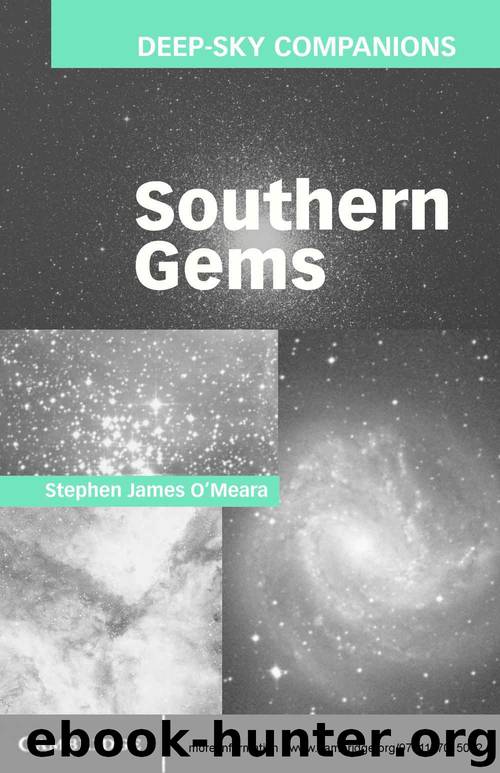Deep-Sky Companions: Southern Gems by O'Meara Stephen James

Author:O'Meara, Stephen James [O'Meara, Stephen James]
Language: eng
Format: azw3
Publisher: Cambridge University Press
Published: 2012-11-29T16:00:00+00:00
At 72×, the cluster fractures into smaller groupings. The pyramid remains bold and bright. The pendant containing HD 111973 reveals at least seven stars that form a smaller pyramid at right angles to the larger brighter one. HD 111973 looks yellow at 72×, as does HD 111904, the magnitude 5.8 star at the northwestern corner of the large, bright pyramid. In February 1997 and again in April 2000, HD 111973 appeared at least 0.5 magnitude (60 percent) brighter than HD 111904 to my eyes – even though, according to Sky Catalogue 2000.0 data, it should be 0.1 magnitude fainter. An undated drawing by Kenneth Glyn Jones in Volume 7 of the Webb Society Deep-Sky Observer’s Handbook (published in 1987) shows HD 111973 as significantly fainter than HD 111904, and this observation was based on a view through a 12-inch reflector. Most photographs I’ve seen show HD 111973 fainter than HD 111904, but that may be an artifact of the photographic emulsion. (Note that in both Ernst Hartung’s and Robert Burnham Jr.’s handbooks the photographs of the cluster have been flipped, with east and west reversed.) Clearly these stars warrant watching.
At 72×, through the 4-inch, SAO 252073 looks more orange than red to me. It is the northeasternmost star in a tiny line of three similarly bright stars oriented northeast to southwest. SAO 252073, to my eyes, is also the faintest of these three stars. Glyn Jones, however, saw it as the brightest. My eyes tend to be blue-sensitive, while other observers are more sensitive to red light, so this discrepancy in brightness might be related to how different observers perceive color and not to any real brightness variations.
Yet Edward James Stone, Her Majesty’s Astronomer at the Cape from 1870 to 1879, suspected that this red star altered its brightness since Sir John Herschel observed it. And the Hipparcos satellite’s database seems to support the notion, for on its watch the star’s apparent visual magnitude appears to have ranged from 7.08 to 7.52. However, Hipparcos didn’t enable astronomers to determine a period of variability or to classify the star’s light curve. Clearly it would behoove someone with a photometer to monitor all the Jewel Box’s supergiant stars for variability.
Moderate magnification reveals other treasures in the Jewel Box. The brightest stars to the southwest of the large pyramid form two semicircles, like wide crowns, facing in opposite directions: one opens to the north-northwest and the other to the southeast. Immediately south of these crowns is a long chain of fainter stars oriented in the same northwest-to-southeast direction as the two semicircles. The void between these groupings may be a long lane of dust.
At high power, the cluster fractures completely and the Jewel Box loses its luster. Most prominent is HD 111973 and its pyramidal pendant. Look for a black cross at the southwestern edge of the pyramid. Look also for a tight double immediately to the northwest of HD 111973 and one about 2′ southeast. For a slightly greater challenge, see if you can detect a 13th-magnitude red star south of SAO 252073.
Download
This site does not store any files on its server. We only index and link to content provided by other sites. Please contact the content providers to delete copyright contents if any and email us, we'll remove relevant links or contents immediately.
Tools of Titans by Timothy Ferriss(7816)
Turbulence by E. J. Noyes(7702)
Astrophysics for People in a Hurry by Neil DeGrasse Tyson(5002)
Secrets of Antigravity Propulsion: Tesla, UFOs, and Classified Aerospace Technology by Ph.D. Paul A. Laviolette(4996)
Design of Trajectory Optimization Approach for Space Maneuver Vehicle Skip Entry Problems by Runqi Chai & Al Savvaris & Antonios Tsourdos & Senchun Chai(4844)
Room 212 by Kate Stewart(4739)
Pale Blue Dot by Carl Sagan(4619)
The David Icke Guide to the Global Conspiracy (and how to end it) by David Icke(4383)
A Journey Through Divination and Astronomy by Publishing Pottermore(4250)
Apollo 8 by Jeffrey Kluger(3513)
Goodbye Paradise(3448)
Losing the Nobel Prize by Brian Keating(3425)
COSMOS by Carl Sagan(3350)
The Five People You Meet in Heaven by Mitch Albom(3335)
How to Read Water: Clues and Patterns from Puddles to the Sea (Natural Navigation) by Tristan Gooley(3240)
Brief Answers to the Big Questions by Stephen Hawking(3240)
How to Read Nature by Tristan Gooley(3080)
The Order of Time by Carlo Rovelli(3073)
A Brief History of Time by Stephen Hawking(2819)
